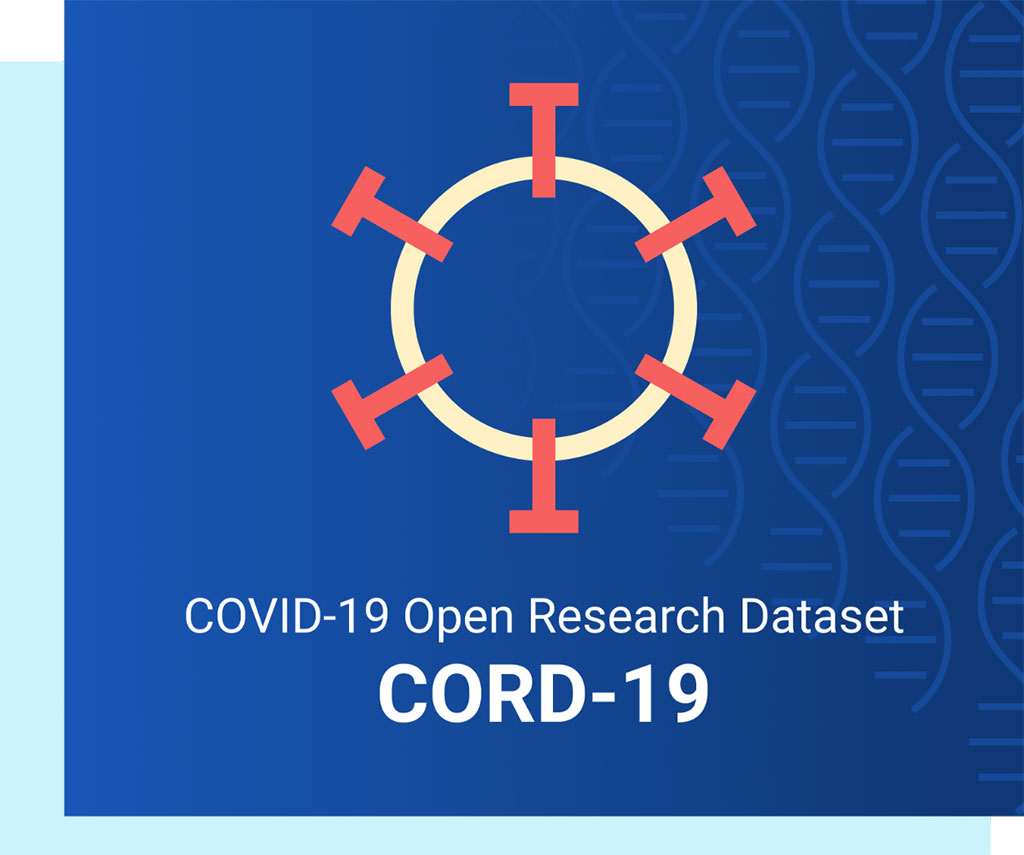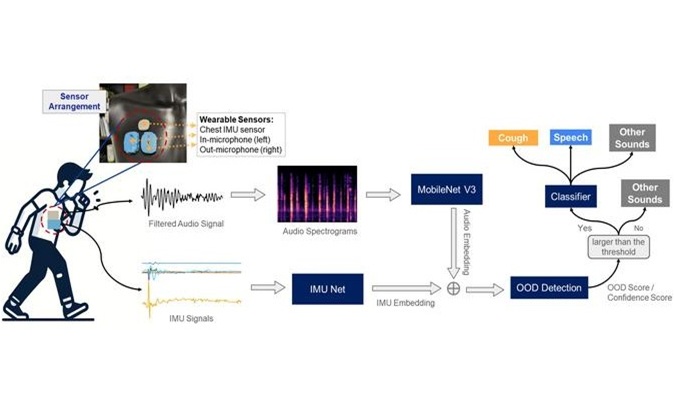White House Urges Using AI to Analyze 29,000 Scholarly Articles on Coronavirus
|
By HospiMedica International staff writers Posted on 25 Mar 2020 |

Illustration
The White House has called on experts in artificial intelligence (AI) to analyze scholarly articles on the coronavirus that could offer insights into treating COVID-19 and controlling the pandemic. Researchers from the Allen Institute for AI, Chan Zuckerberg Initiative (CZI), Georgetown University’s Center for Security and Emerging Technology (CSET), Microsoft, and the National Library of Medicine (NLM) at the National Institutes of Health have released the COVID-19 Open Research Dataset (CORD-19) of scholarly literature about COVID-19, SARS-CoV-2, and the coronavirus group. The dataset represents the most extensive machine-readable coronavirus literature collection available for data and text mining to date, with over 29,000 articles, out of which more than 13,000 have full text.
The collection was constructed via a unique collaboration between Microsoft, NLM, CZI, and the Allen Institute for AI, coordinated by Georgetown University. Microsoft’s web-scale literature curation tools were used to identify and bring together worldwide scientific efforts and results, CZI provided access to pre-publication content, NLM provided access to literature content, and the Allen AI team transformed the content into machine-readable form, making the corpus ready for analysis and study.
The White House has now joined these institutions in issuing a call to action to US AI experts to develop new text and data mining techniques that can help the science community answer high-priority scientific questions related to COVID-19. The CORD-19 resource is available on the Allen Institute’s SemanticScholar.org website and will continue to be updated as new research is published in archival services and peer-reviewed publications. Researchers can submit the text and data mining tools and insights they develop in response to this call to action via the Kaggle platform. Through Kaggle, a machine learning and data science community owned by Google Cloud, these tools will be openly available for researchers around the world.
“Decisive action from America’s science and technology enterprise is critical to prevent, detect, treat, and develop solutions to COVID-19. The White House will continue to be a strong partner in this all hands-on-deck approach. We thank each institution for voluntarily lending its expertise and innovation to this collaborative effort, and call on the United States research community to put artificial intelligence technologies to work in answering key scientific questions about the novel coronavirus,” said Michael Kratsios, US Chief Technology Officer, The White House.
“This valuable new resource is the fruit of unselfish collaboration and now offers the opportunity to find answers to important questions about COVID-19,” said Dr. Dewey Murdick, Director of Data Science at Georgetown University’s Center for Security and Emerging Technology (CSET), who coordinated the cross-team effort. “Once the crisis has passed, we hope this project will inspire new ways to use machine learning to advance scientific research.”
“It’s all-hands on deck as we face the COVID-19 pandemic,” said Dr. Eric Horvitz, Chief Scientific Officer at Microsoft. “We need to come together as companies, governments, and scientists and work to bring our best technologies to bear across biomedicine, epidemiology, AI, and other sciences. The COVID-19 literature resource and challenge will stimulate efforts that can accelerate the path to solutions on COVID-19.”
“Sharing vital information across scientific and medical communities is key to accelerating our ability to respond to the coronavirus pandemic,” said Dr. Cori Bargmann, Head of Science at the Chan Zuckerberg Initiative. “The new COVID-19 Open Research Dataset will help researchers worldwide to access important information faster.”
“We are excited to be part of this collaboration to aid in the COVID-19 response and that the group is making use of our open access subset on coronavirus literature,” said Dr. Patricia Flatley Brennan, Director of the National Library of Medicine at the National Institutes of Health. “Our current collection of more than 10,000 full-text scholarly articles related to coronavirus provides a critical resource for text mining efforts like this one.”
“One of the most immediate and impactful applications of AI is in the ability to help scientists, academics, and technologists find the right information in a sea of scientific papers to move research faster. We applaud the OSTP, WHO, NIH and all organizations that are taking a proactive approach to use the most advanced technology in the fight against COVID-19,” said Dr. Oren Etzioni, Chief Executive Officer of the Allen Institute for AI. “The Allen Institute for AI, and particularly the Semantic Scholar team, is committed to updating and improving this important resource and the associated AI methods the community will be using to tackle this crucial problem.”
“It’s difficult for people to manually go through more than 20,000 articles and synthesize their findings. Recent advances in technology can be helpful here. We’re putting machine readable versions of these articles in front of our community of more than 4 million data scientists. Our hope is that AI can be used to help find answers to a key set of questions about COVID-19,” said Anthony Goldbloom, Co-Founder and Chief Executive Officer at Kaggle.
The collection was constructed via a unique collaboration between Microsoft, NLM, CZI, and the Allen Institute for AI, coordinated by Georgetown University. Microsoft’s web-scale literature curation tools were used to identify and bring together worldwide scientific efforts and results, CZI provided access to pre-publication content, NLM provided access to literature content, and the Allen AI team transformed the content into machine-readable form, making the corpus ready for analysis and study.
The White House has now joined these institutions in issuing a call to action to US AI experts to develop new text and data mining techniques that can help the science community answer high-priority scientific questions related to COVID-19. The CORD-19 resource is available on the Allen Institute’s SemanticScholar.org website and will continue to be updated as new research is published in archival services and peer-reviewed publications. Researchers can submit the text and data mining tools and insights they develop in response to this call to action via the Kaggle platform. Through Kaggle, a machine learning and data science community owned by Google Cloud, these tools will be openly available for researchers around the world.
“Decisive action from America’s science and technology enterprise is critical to prevent, detect, treat, and develop solutions to COVID-19. The White House will continue to be a strong partner in this all hands-on-deck approach. We thank each institution for voluntarily lending its expertise and innovation to this collaborative effort, and call on the United States research community to put artificial intelligence technologies to work in answering key scientific questions about the novel coronavirus,” said Michael Kratsios, US Chief Technology Officer, The White House.
“This valuable new resource is the fruit of unselfish collaboration and now offers the opportunity to find answers to important questions about COVID-19,” said Dr. Dewey Murdick, Director of Data Science at Georgetown University’s Center for Security and Emerging Technology (CSET), who coordinated the cross-team effort. “Once the crisis has passed, we hope this project will inspire new ways to use machine learning to advance scientific research.”
“It’s all-hands on deck as we face the COVID-19 pandemic,” said Dr. Eric Horvitz, Chief Scientific Officer at Microsoft. “We need to come together as companies, governments, and scientists and work to bring our best technologies to bear across biomedicine, epidemiology, AI, and other sciences. The COVID-19 literature resource and challenge will stimulate efforts that can accelerate the path to solutions on COVID-19.”
“Sharing vital information across scientific and medical communities is key to accelerating our ability to respond to the coronavirus pandemic,” said Dr. Cori Bargmann, Head of Science at the Chan Zuckerberg Initiative. “The new COVID-19 Open Research Dataset will help researchers worldwide to access important information faster.”
“We are excited to be part of this collaboration to aid in the COVID-19 response and that the group is making use of our open access subset on coronavirus literature,” said Dr. Patricia Flatley Brennan, Director of the National Library of Medicine at the National Institutes of Health. “Our current collection of more than 10,000 full-text scholarly articles related to coronavirus provides a critical resource for text mining efforts like this one.”
“One of the most immediate and impactful applications of AI is in the ability to help scientists, academics, and technologists find the right information in a sea of scientific papers to move research faster. We applaud the OSTP, WHO, NIH and all organizations that are taking a proactive approach to use the most advanced technology in the fight against COVID-19,” said Dr. Oren Etzioni, Chief Executive Officer of the Allen Institute for AI. “The Allen Institute for AI, and particularly the Semantic Scholar team, is committed to updating and improving this important resource and the associated AI methods the community will be using to tackle this crucial problem.”
“It’s difficult for people to manually go through more than 20,000 articles and synthesize their findings. Recent advances in technology can be helpful here. We’re putting machine readable versions of these articles in front of our community of more than 4 million data scientists. Our hope is that AI can be used to help find answers to a key set of questions about COVID-19,” said Anthony Goldbloom, Co-Founder and Chief Executive Officer at Kaggle.
Latest COVID-19 News
- Low-Cost System Detects SARS-CoV-2 Virus in Hospital Air Using High-Tech Bubbles
- World's First Inhalable COVID-19 Vaccine Approved in China
- COVID-19 Vaccine Patch Fights SARS-CoV-2 Variants Better than Needles
- Blood Viscosity Testing Can Predict Risk of Death in Hospitalized COVID-19 Patients
- ‘Covid Computer’ Uses AI to Detect COVID-19 from Chest CT Scans
- MRI Lung-Imaging Technique Shows Cause of Long-COVID Symptoms
- Chest CT Scans of COVID-19 Patients Could Help Distinguish Between SARS-CoV-2 Variants
- Specialized MRI Detects Lung Abnormalities in Non-Hospitalized Long COVID Patients
- AI Algorithm Identifies Hospitalized Patients at Highest Risk of Dying From COVID-19
- Sweat Sensor Detects Key Biomarkers That Provide Early Warning of COVID-19 and Flu
- Study Assesses Impact of COVID-19 on Ventilation/Perfusion Scintigraphy
- CT Imaging Study Finds Vaccination Reduces Risk of COVID-19 Associated Pulmonary Embolism
- Third Day in Hospital a ‘Tipping Point’ in Severity of COVID-19 Pneumonia
- Longer Interval Between COVID-19 Vaccines Generates Up to Nine Times as Many Antibodies
- AI Model for Monitoring COVID-19 Predicts Mortality Within First 30 Days of Admission
- AI Predicts COVID Prognosis at Near-Expert Level Based Off CT Scans
Channels
Critical Care
view channel
Origami Robots to Deliver Medicine Less Invasively and More Effectively
Delivering medicine to ulcers or other internal sites often requires invasive procedures that can disrupt surrounding tissues and lengthen recovery times. Traditional magnetic actuators used in soft robotics... Read more
Improved Cough-Detection Technology Aids Health Monitoring
Coughing serves as an important biomarker for tracking a variety of conditions and can help monitor the progress of respiratory diseases or predict when someone’s asthma is being exacerbated.... Read moreSurgical Techniques
view channel
Novel Glue Prevents Complications After Breast Cancer Surgery
Seroma and prolonged lymphorrhea are among the most common complications following axillary lymphadenectomy in breast cancer patients. These postoperative issues can delay recovery and postpone the start... Read more
Breakthrough Brain Implant Enables Safer and More Precise Drug Delivery
Delivering medication directly to specific regions of the brain has long been a major challenge in treating neurological disorders. Current implants and infusion systems typically reach only one or two... Read morePatient Care
view channel
Revolutionary Automatic IV-Line Flushing Device to Enhance Infusion Care
More than 80% of in-hospital patients receive intravenous (IV) therapy. Every dose of IV medicine delivered in a small volume (<250 mL) infusion bag should be followed by subsequent flushing to ensure... Read more
VR Training Tool Combats Contamination of Portable Medical Equipment
Healthcare-associated infections (HAIs) impact one in every 31 patients, cause nearly 100,000 deaths each year, and cost USD 28.4 billion in direct medical expenses. Notably, up to 75% of these infections... Read more
Portable Biosensor Platform to Reduce Hospital-Acquired Infections
Approximately 4 million patients in the European Union acquire healthcare-associated infections (HAIs) or nosocomial infections each year, with around 37,000 deaths directly resulting from these infections,... Read moreFirst-Of-Its-Kind Portable Germicidal Light Technology Disinfects High-Touch Clinical Surfaces in Seconds
Reducing healthcare-acquired infections (HAIs) remains a pressing issue within global healthcare systems. In the United States alone, 1.7 million patients contract HAIs annually, leading to approximately... Read moreHealth IT
view channel
Printable Molecule-Selective Nanoparticles Enable Mass Production of Wearable Biosensors
The future of medicine is likely to focus on the personalization of healthcare—understanding exactly what an individual requires and delivering the appropriate combination of nutrients, metabolites, and... Read moreBusiness
view channel
Philips and Masimo Partner to Advance Patient Monitoring Measurement Technologies
Royal Philips (Amsterdam, Netherlands) and Masimo (Irvine, California, USA) have renewed their multi-year strategic collaboration, combining Philips’ expertise in patient monitoring with Masimo’s noninvasive... Read more
B. Braun Acquires Digital Microsurgery Company True Digital Surgery
The high-end microsurgery market in neurosurgery, spine, and ENT is undergoing a significant transformation. Traditional analog microscopes are giving way to digital exoscopes, which provide improved visualization,... Read more
CMEF 2025 to Promote Holistic and High-Quality Development of Medical and Health Industry
The 92nd China International Medical Equipment Fair (CMEF 2025) Autumn Exhibition is scheduled to be held from September 26 to 29 at the China Import and Export Fair Complex (Canton Fair Complex) in Guangzhou.... Read more

















